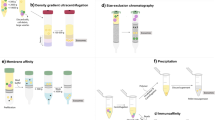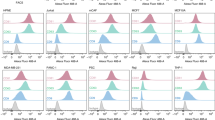Abstract
Exosomes are responsible for cell-to-cell communication and serves as a valuable drug delivery vehicle. However, exosome heterogeneity, non-standardized isolation methods and proteomics/bioinformatics approaches limit its clinical applications. To better understand exosome heterogeneity, biological function and molecular mechanism of its biogenesis, secretion and uptake, techniques in proteomics or bioinformatics were applied to investigate human embryonic kidney cell (293T cell line)-derived exosome proteome and enable an integrative comparison of exosomal proteins and protein-protein interaction (PPI) networks of eleven exosome proteomes extracted from diverse human samples, including 293T (two datasets), dermal fibroblast, mesenchymal stem cell, thymic epithelial primary cell, breast cancer cell line (MDA-MB-231), patient neuroblastoma cell, plasma, saliva, serum and urine. Mapping of exosome biogenesis/secretion/uptake-related proteins onto exosome proteomes highlights exosomal origin-specific routes of exosome biogenesis/secretion/uptake and exosome-dependent intercellular communication. The finding provides insight into comparative exosome proteomes and its biogenesis, secretion and uptake, and potentially contributes to clinical applications.




Similar content being viewed by others
Data Availability
The authors declare that the data that supports the findings of this study are available in the supplementary material of this article.
Abbreviations
- ESCRT:
-
endosomal sorting complexesrequired for transport
- GDDA:
-
Graphlet Degree Distribution agreement
- HDF:
-
human dermal fibroblast
- HEK:
-
human embryonic kidney
- HMSC:
-
human mesenchymal stem cell
- HTEC:
-
human thymic epithelial primary cell
- MS:
-
mass spectrometry
- MVB:
-
multivesicular body
- PPI:
-
protein-protein interaction
- RLIs:
-
receptor-ligand interactions
References
Stahl PD, Raposo G (2018) Exosomes and extracellular vesicles: the path forward. Essays Biochem 62:119–124
Moradian Tehrani R, Verdi J, Noureddini M, Salehi R, Salarinia R, Mosalaei M, Simonian M, Alani B, Ghiasi MR, Jaafari MR, Mirzaei HR, Mirzaei H (2018) Mesenchymal stem cells: a new platform for targeting suicide genes in cancer. J Cell Physiol 233:3831–3845
Borrelli DA, Yankson K, Shukla N, Vilanilam G, Ticer T, Wolfram J (2018) Extracellular vesicle therapeutics for liver disease. J Control Release 273:86–98
Jeppesen DK, Fenix AM, Franklin JL, Higginbotham JN, Zhang Q, Zimmerman LJ, Liebler DC, Ping J, Liu Q, Evans R, Fissell WH, Patton JG, Rome LH, Burnette DT, Coffey RJ (2019) Reassessment of exosome composition. Cell 177:428–445 e418
Pascual M, Ibanez F, Guerri C (2020) Exosomes as mediators of neuron-glia communication in neuroinflammation. Neural Regen Res 15:796–801
Damania A, Jaiman D, Teotia AK, Kumar A (2018) Mesenchymal stromal cell-derived exosome-rich fractionated secretome confers a hepatoprotective effect in liver injury. Stem Cell Res Ther 9:31
Luther KM, Haar L, McGuinness M, Wang Y, Lynch Iv TL, Phan A, Song Y, Shen Z, Gardner G, Kuffel G, Ren X, Zilliox MJ, Jones WK (2018) Exosomal miR-21a-5p mediates cardioprotection by mesenchymal stem cells. J Mol Cell Cardiol 119:125–137
Hayashi T, Hoffman MP (2017) Exosomal microRNA communication between tissues during organogenesis. RNA Biol 14:1683–1689
Zhang R, Jing Y, Zhang H, Niu Y, Liu C, Wang J, Zen K, Zhang CY, Li D (2018) Comprehensive evolutionary analysis of the major RNA-induced silencing complex members. Sci Rep 8:14189
Kim DK, Lee J, Simpson RJ, Lotvall J, Gho YS (2015) EVpedia: a community web resource for prokaryotic and eukaryotic extracellular vesicles research. Semin Cell Dev Biol 40:4–7
Mathivanan S, Fahner CJ, Reid GE, Simpson RJ (2012) ExoCarta 2012: database of exosomal proteins, RNA and lipids. Nucleic Acids Res 40:D1241–D1244
Gonzales PA, Pisitkun T, Hoffert JD, Tchapyjnikov D, Star RA, Kleta R, Wang NS, Knepper MA (2009) Large-scale proteomics and phosphoproteomics of urinary exosomes. J Am Soc Nephrol 20:363–379
Pathan M, Fonseka P, Chitti SV, Kang T, Sanwlani R, Van Deun J, Hendrix A, Mathivanan S (2019) Vesiclepedia 2019: a compendium of RNA, proteins, lipids and metabolites in extracellular vesicles. Nucleic Acids Res 47:D516–D519
Jing Y, Niu Y, Liu C, Zen K, Li D (2018) In silico identification of lipid-binding alpha helices of uncoupling protein 1. Biomed Rep 9:313–317
Clemencon B, Babot M, Trezeguet V (2013) The mitochondrial ADP/ATP carrier (SLC25 family): pathological implications of its dysfunction. Mol Aspects Med 34:485–493
Dautant A, Meier T, Hahn A, Tribouillard-Tanvier D, di Rago JP, Kucharczyk R (2018) ATP synthase diseases of mitochondrial genetic origin. Front Physiol 9:329
Jerebtsova M, Kumari N, Xu M, de Melo GB, Niu X, Jeang KT, Nekhai S (2012) HIV-1 resistant CDK2-knockdown macrophage-like cells generated from 293T cell-derived human induced pluripotent stem cells. Biology (Basel) 1:175–195
Kawamoto E, Park EJ, Shimaoka M (2021) Methods to study integrin functions on exosomes. Methods Mol Biol 2217:265–281
Rosa-Fernandes L, Rocha VB, Carregari VC, Urbani A, Palmisano G (2017) A perspective on extracellular vesicles proteomics. Front Chem 5:102
Thery C, Amigorena S, Raposo G, Clayton A (2006) Isolation and characterization of exosomes from cell culture supernatants and biological fluids.Curr Protoc Cell Biol3.22.1–3.22.29
Choi DS, Lee JM, Park GW, Lim HW, Bang JY, Kim YK, Kwon KH, Kwon HJ, Kim KP, Gho YS (2007) Proteomic analysis of microvesicles derived from human colorectal cancer cells. J Proteome Res 6:4646–4655
He Y, Wu X, Liu X, Yan G, Xu C (2010) LC-MS/MS analysis of ovarian cancer metastasis-related proteins using a nude mouse model: 14-3-3 zeta as a candidate biomarker. J Proteome Res 9:6180–6190
Apweiler R, Bairoch A, Wu CH, Barker WC, Boeckmann B, Ferro S, Gasteiger E, Huang H, Lopez R, Magrane M, Martin MJ, Natale DA, O’Donovan C, Redaschi N, Yeh LS (2004) UniProt: the Universal protein knowledgebase. Nucleic Acids Res 32:D115–D119
Razumovskaya J, Olman V, Xu D, Uberbacher EC, VerBerkmoes NC, Hettich RL, Xu Y (2004) A computational method for assessing peptide- identification reliability in tandem mass spectrometry analysis with SEQUEST. Proteomics 4:961–969
Skogberg G, Lundberg V, Berglund M, Gudmundsdottir J, Telemo E, Lindgren S, Ekwall O (2015) Human thymic epithelial primary cells produce exosomes carrying tissue-restricted antigens. Immunol Cell Biol 93:727–734
Sun Y, Huo C, Qiao Z, Shang Z, Uzzaman A, Liu S, Jiang X, Fan LY, Ji L, Guan X, Cao CX, Xiao H (2018) Comparative proteomic analysis of exosomes and microvesicles in human saliva for lung cancer. J Proteome Res 17:1101–1107
Marimpietri D, Petretto A, Raffaghello L, Pezzolo A, Gagliani C, Tacchetti C, Mauri P, Melioli G, Pistoia V (2013) Proteome profiling of neuroblastoma-derived exosomes reveal the expression of proteins potentially involved in tumor progression. PLoS ONE 8:e75054
Melo SA, Luecke LB, Kahlert C, Fernandez AF, Gammon ST, Kaye J, LeBleu VS, Mittendorf EA, Weitz J, Rahbari N, Reissfelder C, Pilarsky C, Fraga MF, Piwnica-Worms D, Kalluri R (2015) Glypican-1 identifies cancer exosomes and detects early pancreatic cancer. Nature 523:177–182
Karimi N, Cvjetkovic A, Jang SC, Crescitelli R, Hosseinpour Feizi MA, Nieuwland R, Lotvall J, Lasser C (2018) Detailed analysis of the plasma extracellular vesicle proteome after separation from lipoproteins. Cell Mol Life Sci 75:2873–2886
Lai RC, Tan SS, Teh BJ, Sze SK, Arslan F, de Kleijn DP, Choo A, Lim SK (2012) Proteolytic potential of the MSC exosome proteome: Implications for an exosome-mediated delivery of therapeutic proteasome. Int J Proteomics 2012:971907
Bellavia D, Raimondo S, Calabrese G, Forte S, Cristaldi M, Patinella A, Memeo L, Manno M, Raccosta S, Diana P, Cirrincione G, Giavaresi G, Monteleone F, Fontana S, De Leo G, Alessandro R (2017) Interleukin 3- receptor targeted exosomes inhibit in vitro and in vivo chronic myelogenous leukemia cell growth. Theranostics 7:1333–1345
Gonzalez-Calero L, Martinez PJ, Martin-Lorenzo M, Baldan-Martin M, Ruiz-Hurtado G, de la Cuesta F, Calvo E, Segura J, Lopez JA, Vazquez J, Barderas MG, Ruilope LM, Vivanco F, Alvarez-Llamas G (2017) Urinary exosomes reveal protein signatures in hypertensive patients with albuminuria. Oncotarget 8:44217–44231
Pathan M, Keerthikumar S, Ang CS, Gangoda L, Quek CY, Williamson NA, Mouradov D, Sieber OM, Simpson RJ, Salim A, Bacic A, Hill AF, Stroud DA, Ryan MT, Agbinya JI, Mariadason JM, Burgess AW, Mathivanan S (2015) FunRich: an open access standalone functional enrichment and interaction network analysis tool. Proteomics 15:2597–2601
Shannon P, Markiel A, Ozier O, Baliga NS, Wang JT, Ramage D, Amin N, Schwikowski B, Ideker T (2003) Cytoscape: a software environment for integrated models of biomolecular interaction networks. Genome Res 13:2498–2504
Szklarczyk D, Morris JH, Cook H, Kuhn M, Wyder S, Simonovic M, Santos A, Doncheva NT, Roth A, Bork P, Jensen LJ, von Mering C (2017) The STRING database in 2017: quality-controlled protein-protein association networks, made broadly accessible. Nucleic Acids Res 45:D362–D368
Kuchaiev O, Stevanovic A, Hayes W, Przulj N (2011) GraphCrunch 2: Software tool for network modeling, alignment and clustering. BMC Bioinformatics 12:24
Calvo SE, Clauser KR, Mootha VK (2016) MitoCarta2.0: an updated inventory of mammalian mitochondrial proteins. Nucleic Acids Res 44:D1251–D1257
Han JD, Bertin N, Hao T, Goldberg DS, Berriz GF, Zhang LV, Dupuy D, Walhout AJ, Cusick ME, Roth FP, Vidal M (2004) Evidence for dynamically organized modularity in the yeast protein-protein interaction network. Nature 430:88–93
Jeong H, Mason SP, Barabasi AL, Oltvai ZN (2001) Lethality and centrality in protein networks. Nature 411:41–42
Rual JF, Venkatesan K, Hao T, Hirozane-Kishikawa T, Dricot A, Li N, Berriz GF, Gibbons FD, Dreze M, Ayivi-Guedehoussou N, Klitgord N, Simon C, Boxem M, Milstein S, Rosenberg J, Goldberg DS, Zhang LV, Wong SL, Franklin G, Li S, Albala JS, Lim J, Fraughton C, Llamosas E, Cevik S, Bex C, Lamesch P, Sikorski RS, Vandenhaute J, Zoghbi HY, Smolyar A, Bosak S, Sequerra R, Doucette-Stamm L, Cusick ME, Hill DE, Roth FP, Vidal M (2005) Towards a proteome-scale map of the human protein-protein interaction network. Nature 437:1173–1178
D’Souza-Schorey C, Schorey JS (2018) Regulation and mechanisms of extracellular vesicle biogenesis and secretion. Essays Biochem 62:125–133
Pedrioli G, Piovesana E, Vacchi E, Balbi C (2021) Extracellular vesicles as promising carriers in drug delivery: considerations from a cell biologist’s perspective. Biology (Basel) 10:376
Li P, Kaslan M, Lee SH, Yao J, Gao Z (2017) Progress in exosome isolation techniques. Theranostics 7:789–804
Gho YS, Lee C (2017) Emergent properties of extracellular vesicles: a holistic approach to decode the complexity of intercellular communication networks. Mol Biosyst 13:1291–1296
Miryala SK, Anbarasu A, Ramaiah S (2018) Discerning molecular interactions: a comprehensive review on biomolecular interaction databases and network analysis tools. Gene 642:84–94
Acknowledgements
This work was supported by the National Natural Science Foundation of China (grant numbers 31470716, 31000323 and 31070672) and the Natural Science Foundation of Jiangsu Province (grant number BK20131272).
Author information
Authors and Affiliations
Corresponding author
Additional information
Publisher’s Note
Springer Nature remains neutral with regard to jurisdictional claims in published maps and institutional affiliations.
Electronic Supplementary Material
Below is the link to the electronic supplementary material.
Rights and permissions
Springer Nature or its licensor (e.g. a society or other partner) holds exclusive rights to this article under a publishing agreement with the author(s) or other rightsholder(s); author self-archiving of the accepted manuscript version of this article is solely governed by the terms of such publishing agreement and applicable law.
About this article
Cite this article
Yang, H., Zhang, H., Gu, H. et al. Comparative Analyses of Human Exosome Proteomes. Protein J 42, 365–373 (2023). https://doi.org/10.1007/s10930-023-10100-0
Accepted:
Published:
Issue Date:
DOI: https://doi.org/10.1007/s10930-023-10100-0




